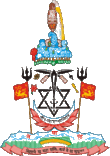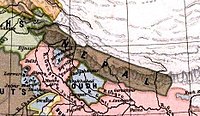Shah dynasty
This article needs additional citations for verification. (April 2012) |
| Shah dynasty | |
|---|---|
 | |
| Country | |
| Founded | 16th century |
| Founder | Kulamandan Shah (Khan) |
| Current head | Gyanendra Bir Bikram Shah |
| Final ruler | Gyanendra Bir Bikram Shah |
| Titles |
|
| Estate(s) | of Nepal |
| Deposition | 28 May 2008 (presently as pretender) |
| History of Nepal |
|---|
 |
|
|
The Shah dynasty was the ruling Khas Rajput (Thakuri) dynasty of the Kingdom of Gorkha until 1768, the growing Nepalese Empire and finally of the Kingdom of Nepal from 1768 to 28 May 2008.
Origin
According to legends, one of the earliest Shah rulers was Rishi-raj Rana-ji, of the lunar dynasty. He was made ruler of Chittorgarh and received the title of Bhattarak.[1] The lunar dynasty remained in power for thirteen generations. Then, the Muslim Yavanas took power. The Bhattarak had to abdicate and could only retain his caste family name, Rana-ji. The rajas were titled Rana-ji for four generations and Rana-ji Rava for a further seventeen generations.
Akbar, the Mughal emperor, (1542-1605) wished to marry the daughter of Fatte Sinha Rana-ji Rava. Akbar was refused because he was of an unsatisfactory caste. This decision led to war. Many rajput, including Fatte Sinha Rana-ji Rava, were killed. The survivors of the war were led by Udaybam Rana-ji Rava. They founded a settlement, Udaipur.[1]
Manmath Rana-ji Rava went to Ujjain. His son went to Ridi in the northern hills and in 1417 AD (Saka 1945), to Sargha, and then to Khium in Bhirkot. There, he cultivated the land. The new ruler of Khium had sons, Kancha and Micha.[1] Their bartabandha (the taking of the Bharmanical thread) was performed. Plans for the boys to marry the daughters of the Raghibanshi Rajputs were made. Kancha, the elder son went to Dhor. He conquered Mangart and reigned over Garhon, Sathum and Birkot. Micha, the younger son, went to Nuwakot in the far west and became ruler there.[1]
From Micha, a dynasty of seven rajas commenced in Nuwakot. Kumandan, the eldest son of Jagdeva, became ruler of Kaski. He was favoured and became Sah and succeeded his father. Kalu, the second son was sent to Dura Danda in Lamjung at the people's request to become their king. Kalu was killed by the Sekhant tribe. In the 1500s, another son, Yasobramha, became the ruler of Lamjung.[1] The descendants of Yasobramha conquered the Ghale people of neighbouring Ligligkot, now in Gorkha.
Dravya Shah
Dravya Shah was the first Shah king of Gorkha. Previously, the local Ghale people had chosen their king from the winners of an annual running race. Dravya Shah was not a physically robust man but he tricked his way to the win. He was backed by the Bhattarai, Aryal, Adhikari, Pant and Acharya clans who were Brahmin. By 1570, when Dravya Shah died, the running race was but a memory among the people. Dravya Shah used the army of the Magar (an ancient tribe of Nepal) to invade neighbouring states and his successors continued this aggression to increase the territory belonging to Gorkha. Kaji Ganesh Pande was his first minister of Gorkha.[citation needed]
Absolute monarchy (1768–1846)
In 1743, Prithvi Narayan Shah became the ruler of Gorkha. He declared war with other principalities, defeating them one by one. In September 1768, he established the unified kingdom of Nepal. He became the first king of Nepal. He, his sons and their successors continued fighting and defeating other kingdoms and enlarging the kingdom of Nepal. In 1814, the Anglo–Nepalese War between Nepal and the East India Company began. By 1815, the Shah king had been thoroughly defeated. By 1816, Nepal had lost one third of its territory. The Shah kings continued to rule as absolute monarch until 1846 when the political order changed from absolute monarchy to a constitutional monarchy.
Hereditary prime ministers (1846–1951)

In 1846, the Rana dynasty gained power in Nepal. The Rana ruler became prime minister and reduced the King of Nepal to a figurehead position. The Ranas ruled Nepal as hereditary prime ministers though in the name of the figurehead king. In 1950, the Shah king King Tribhuvan was forced into exile in India. He and his family, including the crown prince Mahendra, were saved. After India became a secular state in 1950, and the remaining rajas retired, Nepal was the only remaining Hindu kingdom. In 1951, with the help of India, a popular politician common man Matrika Prasad Koirala became the prime minister of Nepal. Tribhuvan returned to Kathmandu. The Shah dynasty regained control and the prime minister, Mohan Shamsher Jang Bahadur Rana, resigned. King Tribhuvan ruled until 1955 and King Mahendra ruled until 1972. Mahendra's son, Birendra, became king.
Constitutional monarchy (1990–2008)
In 1990, under King Birendra, Nepal became a constitutional monarchy. King Birendra believed in cooperation between the absolute power of the monarchy and democratic governance. His brother, Gyanendra and his wife Queen Aishwarya staunchly opposed this.[citation needed]
Murder of the royal family
On 1 June 2001, a number of members of the Shah dynasty were murdered in the royal palace. A High Commission report concluded that the royal family was slaughtered by Crown Prince Dipendra. This remains controversial.[citation needed] Among the dead were the Crown Prince's father, King Birendra and his brother, Prince Nirajan. After the attack, Dipendra was in a coma and was declared king for a short time. He died a few days later. Gyanendra Bir Bikram Shah Dev, Dipendra's uncle, took the throne. In February 2005, he dismissed the parliament in order to govern in his own right.
Abolition of the Shah monarchy
On 24 December 2007, the Nepalese Constituent Assembly met. It was decided by majority vote that the monarchy would be abolished in 2008 after the Constituent Assembly elections.[2] On 28 May 2008, the Assembly declared Nepal a Federal Democratic Republic and the monarchy was abolished, removing the Shah dynasty from power. Kul Bahadur Gurung said of the 601 member assembly, 560 voted in favour, 4 were against and 37 were absent or abstained.[citation needed] After this Assembly agreement involving the Nepali Congress, the Communist Party of Nepal (Unified Marxist–Leninist) and the Communist Party of Nepal (Maoist), Gyanendra stepped down.
Gyanendra vacated his palace in Kathmandu which later became a museum. Until they could find permanent accommodation, the royal couple were offered residence as commoners at the Nagarjuna Palace, a former royal summer residence. The Nagarjuna palace lies in forested hills about eight kilometres (five miles) northwest of Kathmandu.
Monarchs of Shah dynasty (1768–2008)
| Name | Lifespan | Reign start | Reign end | Notes | Family | Image |
|---|---|---|---|---|---|---|
Prithvi Narayan Shah
| 7 January 1723[3] – 11 January 1775 (aged 52) | 25 September 1768 | 11 January 1775 | Son of Nara Bhupal Shah | Shah |  |
Pratap Singh Shah
| 16 April 1751 – 17 November 1777 (aged 26) | 11 January 1775 | 17 November 1777 | Son of Prithvi Narayan Shah | Shah |  |
Rana Bahadur Shah
| 25 May 1775 – 25 April 1806 (aged 30) | 17 November 1777 | 8 March 1799 (abdicated) | Son of Pratap Singh Shah | Shah |  |
Girvan Yuddha Bikram Shah
| 19 October 1797 – 20 November 1816 (aged 19) | 8 March 1799 | 20 November 1816 | Son of Rana Bahadur Shah | Shah | Girvan Yuddha Bikram Shah of Nepal |
Rajendra Bikram Shah
| 3 December 1813 – 10 July 1881 (aged 67) | 20 November 1816 | 12 May 1847 (abdicated) | Son of Girvan Yuddha Bikram Shah | Shah |  |
Surendra Bikram Shah
| 20 October 1829 – 17 May 1881 (aged 51) | 12 May 1847 | 17 May 1881 | Son of Rajendra Bikram Shah | Shah |  |
Prithvi Bir Bikram Shah
| 18 August 1875 – 11 December 1911 (aged 36) | 17 May 1881 | 11 December 1911 | Grandson of Surendra Bikram Shah | Shah |  |
| Tribhuvan Bir Bikram Shah (1st reign)
| 30 June 1906 – 13 March 1955 (aged 48) | 11 December 1911 | 7 November 1950 (went into exile) | Son of Prithvi Bir Bikram Shah | Shah | Tribhuvan Bir Bikram Shah of Nepal |
| Gyanendra Bir Bikram Shah (1st reign)
| 7 July 1947 | 7 November 1950 | 7 January 1951 (stepped down) | Grandson of Tribhuvan Bir Bikram Shah | Shah |  |
| Tribhuvan Bir Bikram Shah (2nd reign)
| 30 June 1906 – 13 March 1955 (aged 48) | 7 January 1951 | 13 March 1955 | Son of Prithvi Bir Bikram Shah | Shah | Tribhuvan Bir Bikram Shah of Nepal |
Mahendra Bir Bikram Shah
| 11 June 1920 – 31 January 1972 (aged 51) | 14 March 1955 | 31 January 1972 | Son of Tribhuvan Bir Bikram Shah | Shah |  |
Birendra Bir Bikram Shah
| 28 December 1945 – 1 June 2001 (aged 55) | 31 January 1972 | 1 June 2001 (assassinated) | Son of Mahendra Bir Bikram Shah | Shah |  |
Dipendra Bir Bikram Shah
| 27 June 1971 – 4 June 2001 (aged 29) | 1 June 2001 | 4 June 2001 (assassinated) | Son of Birendra Bir Bikram Shah | Shah | Dipendra Bir Bikram Shah of Nepal |
| Gyanendra Bir Bikram Shah (2nd reign)
| 7 July 1947 | 4 June 2001 | 28 May 2008 (deposed; presently as pretender) | Son of Mahendra Bir Bikram Shah | Shah |  |
Maternal roots of Shah dynasty
Family tree of the first seven Mughal emperors:
See also
References
- ^ a b c d e Daniel Wright, History of Nepāl, Cambridge University Press, 1877, Nepal. Chapter X, page 273
- ^ "Nepalese monarchy to be abolished." BBC 24 December 2007 Accessed 25 December 2007.
- ^ Accordingly Royal Ark, he was born on 25 December 1722
External links
- Royal Court of Nepal Nepalese government website.
- The Royal House of Nepal Royal Ark website.
- Gregson J. "Massacre at the palace; the doomed royal dynasty of Nepal." 2002.
